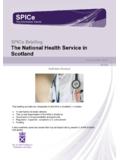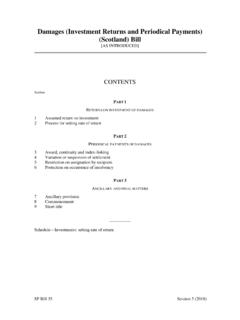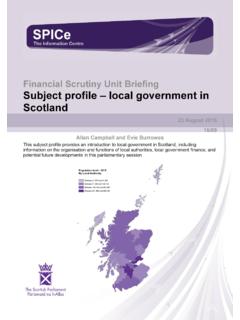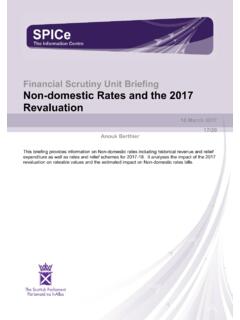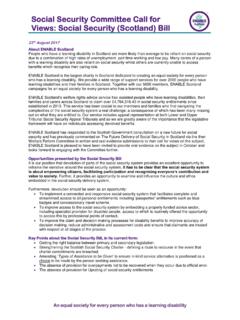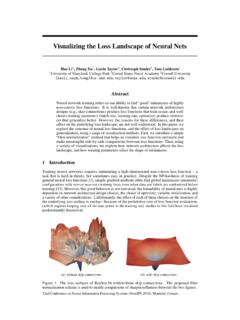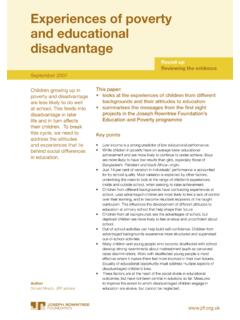Transcription of Closing The Attainment Gap What Can Schools Do
1 The Sc ot tish Parliament and Scottis h Parliament I nf or mation C entre l ogos . SPICe Briefing Closing The Attainment Gap: what Can Schools Do? 19 August 2016 16/68 Geetha Marcus This briefing highlights five guiding principles and six key strategies, gathered from evidence-based educational research, that have been proved effective in Closing the Attainment gap both nationally and internationally. The author of this briefing is an education specialist and former head teacher who recently completed her doctoral studies. This briefing is the result of research carried out as part of the author s SGSSS doctoral placement with SPICe. 2 CONTENTS EXECUTIVE SUMMARY .. 3 INTRODUCTION .. 5 what SIGNIFICANT PRINCIPLES UNDERLIE Closing THE Attainment GAP? .. 8 The Child at the Centre .. 8 Individual Needs .. 9 Building Respect and Trust .. 10 Balance between Autonomy and Accountability.
2 10 what SIGNIFICANT EDUCATIONAL STRATEGIES CAN SUPPORT Closing THE Attainment GAP? .. 13 High Quality Teachers and Teaching .. 13 Strong school Leadership .. 17 Reflective Practice and Research .. 19 Networks of Support and Collaboration .. 21 Effective Assessment and Evaluation .. 23 Early Intervention .. 24 ANNEXE A: GLOSSARY OF TERMS .. 26 ANNEXE B: KEY LEGISLATION IN SCOTTISH school EDUCATION .. 28 Year .. 28 Title .. 28 Key Provisions .. 28 ANNEXE C: Attainment GAP .. 29 SOURCES .. 30 3 EXECUTIVE SUMMARY The link between socio-economic disadvantage, academic Attainment and job prospects is a global issue (OECD, 2011, 2014). In Scotland, various measures have been taken over the years to attempt to break the seemingly inevitable intergenerational cycle of poverty and to address a lack of positive and sustained destinations (Education Scotland, 2008; 2016a, 2016b). There remains a strong correlation between a pupil s socio-economic status and their educational Attainment .
3 Pupils from disadvantaged backgrounds have a higher chance of not succeeding in school . KEY POINTS This briefing focuses on what Schools can do to close the Attainment gap. It identifies five guiding principles: 1. Putting the child at the centre 2. Addressing individual needs 3. Building respect and trust 4. Balancing autonomy and accountability 5. Enabling flexibility and creativity And six key areas/interventions, gathered from evidence-based educational research both nationally and internationally, that have collectively proved effective in Closing the Attainment gap. Providing: 1. High quality teachers and teaching 2. Strong school leadership 3. Reflective practice and research 4. A network of support and collaboration 5. Effective assessment and evaluation 6. Early intervention However, a reminder and caution: 1. In addition to having economic aims and advantages, education is a moral activity subjective, complex and difficult to measure.
4 2. The relationship between theory and practice is often both complicated and subtle, and this is especially the case in an area like education, which necessarily involves values as well as facts (Winch and Gingell, 2008: 212). 3. These differences have a significant impact on classroom practice, educational debate and research, and public policy. 4. Closing the Attainment gap is therefore by implication equally complex. There is not one gap , nor one solution for how gaps can be closed (Florian (2016:3). The principles and strategies highlighted in this paper collectively provide a best bet to 4 help resolve the stubborn issues of deprivation and education s social gaps (OECD, 2015: 14). This briefing acknowledges that, while Schools have an important role in Closing the Attainment gap, what they contribute is only one aspect of the multi-dimensional efforts across various organisations, policies and practices .)
5 5 INTRODUCTION The link between socio-economic disadvantage, academic attainment1 and job prospects is a global issue (OECD, 2011, 2014). In Scotland, the concern for widening educational opportunities and educational success for all, regardless of gender, social and cultural background is a historical priority that dates back to the humanist movement of the 18th Century. Various measures have been taken over the years to attempt to break the seemingly inevitable intergenerational cycle of poverty and lack of positive and sustained destinations (Education Scotland, 2008; 2016a, 2016b). An OECD (2007: 14) report commissioned by the Scottish Government entitled Quality and Equity of Schooling in Scotland, indicated that Scotland performs at a consistently very high standard in the Programme for International Student Assessment (PISA) and that Scotland also has one of the most equitable school systems among OECD countries.
6 In 2015, the OECD s report on Improving Schools in Scotland again highlighted many strengths in Scottish education, and the Scottish Government recognises that Scotland has a good education system (Scottish Government, 2016: 2). However, recent reports also suggest that there are significant challenges (Scottish Government, 2016: 3). There remains a strong correlation between a pupil s socio-economic status and their educational Attainment . Pupils from disadvantaged backgrounds have a higher chance of not succeeding in school . Socio-economic status exerts a powerful influence on Attainment results in Schools , but this link is not just about poverty ( those from low socio-economic backgrounds) (Annexe A and C). In Scotland, pupils in the 40 per cent least deprived areas2 are not living in poverty, yet they still do worse on average than those in the 20 per cent least deprived areas, who in turn do worse than those in the top 10 per cent (SPICe Briefing 16/33, 2016: 24).
7 Furthermore, other disadvantages based on culture, ethnicity, gender, sexuality and disability also intersect to produce inequalities that can impact on a pupil s performance in school and potential to reach positive and sustained destinations (Arshad, 2005; Equality and Human Rights Commission, 2015; 2016a; Davis, 2016). The PISA3 2009 report (OECD, 2011) identified that, across OECD countries, despite being from disadvantaged backgrounds, one-third of disadvantaged students identified as resilient , and beat the odds stacked against them . The report found three factors that defined these resilient students spending more time in class, confidence in their academic ability, motivation and an intrinsic personal drive to succeed. The report concluded that Schools may have an important role to play in fostering resilience (OECD, 2011: 4) (See Annexe A). Schools also have a role to play in reducing inequalities.
8 Davis (2016: 2) argues that there is a need for greater recognition and action on how intersectional discrimination and inequalities impact on wellbeing and prevent children from participating and learning effectively . Other studies confirm this argument (Hick et al., 2011; Konstantoni et al., 2014; OECD, 2014; Hopkins et al., 2015). The PISA results suggest that whilst increased learning time in class, is not in itself sufficient, there are a number of policies that can improve performance among disadvantaged students (OECD, 2011: 4). In a statement to Parliament, the First Minister declared that the Scottish Government will draw on successful ideas from around the world in order to close the Attainment gap in Scotland 1 The term Attainment , as opposed to achievement, is used throughout the paper. An explanation of both terms can be found in the Annexe A.
9 2 As measured by the Scottish Index of Multiple Deprivation, a composite measure of deprivation in small geographical areas. 3 PISA is an international sample survey of literacy, mathematics and science ability amongst 15 year olds. 6 (Sturgeon, 2016). She introduced a range of initiatives not only in the education sector, but across health, childcare, social services, welfare, and employment that would be undertaken. The Scottish Government recognises that ensuring equality of opportunity for young people starts well before the school years and extends far beyond the school gates (Sturgeon, 2016). This briefing focuses on what Schools can do to close the Attainment gap. It highlights six key areas/interventions, gathered from evidence-based educational research both nationally and internationally, that have collectively proved effective in Closing the Attainment gap, but this is not exhaustive.
10 It is also worth pointing out that, while the focus of this paper is on what Schools can do, there is significant variation between and within Schools in terms of pupil Attainment (Sammons, 1995; Sammons et al., 1997): Few Schools are universally good at teaching across all subject areas. Conversely, few are universally bad at teaching them all. Only a very small minority of Schools and departments perform consistently over time as effectiveness fluctuates from one year to the next. There is some evidence that both Schools and departments are differentially effective with pupils from different social and ethnic backgrounds as well as high and low attainers, for reasons that are not as yet well understood. (Sammons et al., 1997: x) Therefore, teachers collective practices and interactions cannot be ignored (Sammons et al., 1997: x). Structural and specific policy interventions are useful, but the quality of teachers and teaching quality is vital.

